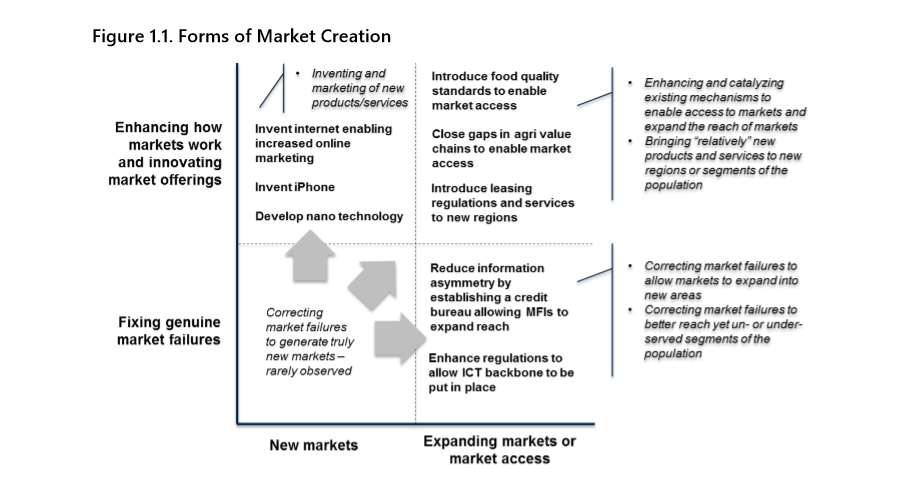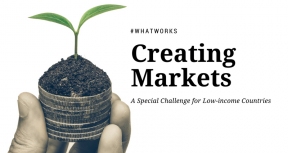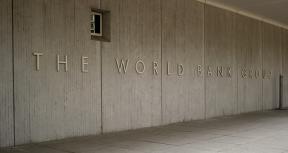Identifying Market Creating Opportunities
The Bank Group’s traditional Advisory Services and Analytics and the country-wide Systematic Country Diagnostics cover the private sector agenda, but too unevenly to allow for the design of a program of World Bank Group interventions that help client countries create markets.
IEG recommends enhancing the understanding of market creation opportunities, including through the recently introduced Country Private Sector Diagnostics, and ensure that such knowledge is adequately reflected in the Country Partnership Framework (CPF)
Read More about Identifying Market Creation Opportunities and Constraints (Chapter 3)
Channels through which IFC contributes to market creation
Evidence from case studies suggests that IFC’s activities and interventions that contribute to creating markets can be clustered around four interrelated channels:
- Fostering innovation in the form of new products, processes, standards, or financing instruments, to increase productivity and enhance market competition and trade competitiveness, thereby contributing to market creation. Across all 16 case studies IFC was found to contribute the most to creating markets through fostering innovation.
- Generating demonstration effects such as supporting a new firm entering the market to compete, or supporting an incumbent launching a pioneering product or service in an established market, or helping a client issue a new financing instrument to mobilize capital. Generating demonstration effects is the second most prominent channel through which IFC contributes to market creation. according to the case studies, but they require the right conditions to materialize.
- Enhancing skills, capacities and governance structures at firm level to provide competitive advantage in the market place, essential for creating markets. IFC’s role enhancing the skills, capacities and governance at firm level was evidenced in case studies carried out in the financial inclusion and agribusiness areas; and
- Supporting integration into value chains to contribute to market creation through fostering linkages and inclusion of underserved communities. Evidence of integration effects of IFC intervention was only observed in agribusiness case studies. To achieve a market integration effect requires a value chain focus based on a solid technical understanding of the targeted value chains, market actors, and prevailing technologies.
Read More about the the Channels of Market Creation (Chapter 2)
Results from IFC’s market creating interventions
Below are the two sets of indicators through which IEG gauged the success of market creation activities from IFC’s interventions, along with a high-level summary of IEG’s findings based on evaluation case studies:
1. Increased size or reach of markets, enhanced competition, lower prices, enhanced environmental sustainability and market resilience standards:
- IFC’s market creation efforts resulted in increased size or reach of markets, often for small and medium enterprises. They also contributed to competition by lowering barriers to entry or increasing the number of market participants. However, such competition did not lead systematically to lower prices.
- Beyond competition-related effects, IFC’s support also helped markets to enhance environmental sustainability and resilience, albeit to a limited extent.
- Market creation effects were sector specific.
2. Provision of sustainable market access to the poor:
- Providing market access to the poor, in a sustainable manner, remains a challenge.
- The evaluation confirmed a general lack of evidence of the direct welfare implication of market creation efforts for the poor.
- Evidence from previous IEG evaluations, the 16 case studies, and portfolio reviews, point to the need to invest in and improve the monitoring and evaluation resources (M&E) to understand the effects of market creation on the poor.
Therefore, IEG recommends that the World Bank Group enhance access to markets for the underserved groups, including the poor, and entailing adequate M&E provisions to understand how market creation affect the poor.
Success factors driving the Bank Group’s market creation results
The evaluation case studies confirmed that the enabling environment is essential for market creation, an area where the World Bank plays a leading role.
The following specific aspects related to the enabling environment were derived from the evaluation case studies:
- Regulation quality. Deficiencies in the regulatory and legal framework slow down market creation and can jeopardize the progress achieved in building markets;
- Private sector reach. When trying to reach the poor, private sector investments perform better when combined with regulatory reform interventions. Nonetheless, good sector regulations are not enough;
- Country-wide perspective. Market creation requires a broader view of a country’s constraints to market creation, including country governance capacity, transparency, efficient and predictable public administration, and physical infrastructure.
- Private sector experience and capacity. Countries with limited experience in working with the private sector, such as many low-income countries (or fragility and conflict-affected situations (FCS) face the greatest challenges in creating markets given their growing debt burden and limited domestic resource mobilization.
Overall, the evidence points to the significance of the “Cascade” approach as a tool for implementing the Bank Group’s Maximizing Finance for Development (MFD) objectives, with its focus on remedying the obstacles that block private sector solutions and help client countries create markets.
Other success factors relate to work quality aspects of World Bank Group engagements with clients:
- Local presence. Presence of Bank Group staff, their familiarity with local risks, and the quality of engagement matter.
- Policy dialogue. Long-term policy dialogue and design flexibility can help navigate political change. Early and broad stakeholder involvement matters.
- Programmatic involvement. Overly complex project design often causes low performance.
IFC’s risk-taking capabilities.
Market creation opportunities develop with the application of modern technologies, for example in FinTech, the renewable energy sector or ICT. Seizing those opportunities requires cutting-edge knowledge, nimbleness and appetite for risk, coupled with the expertise to manage those risks. The case studies suggest the need to have an adequate appetite for risk and a long-term engagement horizon to fulfil the Bank Group’s ambition to advance the MFD agenda in IDA countries, Fragile and Conflict States (FCS), and other structurally weak economies.
IEG recommends the World Bank Group regularly assess the risk-taking capabilities of IFC to carry out its market creation activities in IDA and other structurally weak economies in a financially sustainable way.
Also See:
Video summarizing the IFC's creating markets agenda, and IEG's evaluative findings:
The Creating Markets series summarizes detailed lessons of experience and key takeaways regarding the World Bank Group's Creating Markets concept. Findings from relevant IEG evaluations over the last ten years provide a rich source of lessons and determinants of success that are relevant for the implementation of the Cascade Approach and the success of the Creating Markets concept.


















